
by Rachel Gulbraa, NOAA Office of Ocean Exploration and Research
September 16, 2019
As a newcomer to life at sea, one of the most striking things about my time on NOAA Ship Okeanos Explorer these past three weeks was the sheer vastness of the waters that our ship sailed through. To look out in every direction and see nothing but the changing waters around us—and to know that these waters also extended for miles beneath us—impressed on me how incredible it was that with the right preparation, the ship could routinely sail through these vast expanses of ocean to map and explore its depths. Not only that, but having spent some time now among the people who regularly call the ship home, I learned that this is done so with camaraderie, professionalism, and good humor, all of which shape the character of life onboard. Something that’s not always obvious from an outside perspective are the many roles that are essential for the ship to function in order to fulfill its mission of scientific exploration and outreach. From driving the ship to feeding its people, from maintaining and repairing the ship, or the remotely operated vehicles (ROVs), to creating the striking film and photography we share—or ensuring we can share it in real time; to dealing with the logistics of coordinating permits, travel, safety, community and scientific input—it takes a village. But how did all of these people, with their unique skill sets and contributions, end up on the Okeanos Explorer? Some have been onboard for years, and others joined just for this expedition. Some were very intentional in the career paths that led them to the ship, while others followed a series of opportunities that led them to the same endpoint. The career paths and choices that brought such a diverse collection of people to such a diverse set of roles are varied—if you’re interested in the human stories of the Okeanos, or are perhaps considering a career in support of ocean exploration yourself—read on!
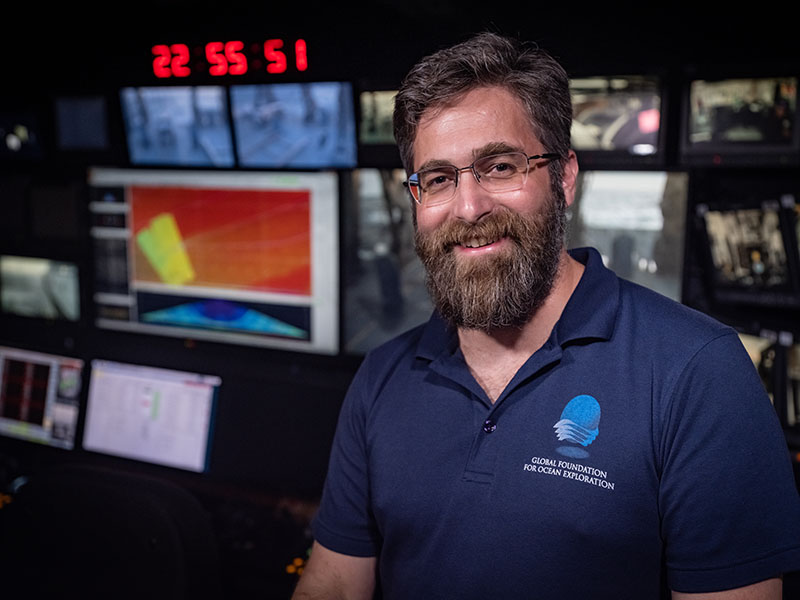
Image courtesy of the NOAA Office of Ocean Exploration and Research, Deep Connections 2019. Download larger version (jpg, 70.3 MB).
ROV/Software/Data Engineer
Global Foundation for Ocean Exploration (GFOE)
The lowdown—what is your role on the ship?
When I’m aboard the Okeanos Explorer I am a leader in GFOE’s software development, data management, and computing efforts. I am also qualified to stand ROV related watches, including the roles of ROV pilot, copilot, and navigator, and as winch operator and launch and recovery deck team member. I generally start my day by checking the data acquisition systems. To collect and transmit the data we send to shore, it takes hundreds of networked devices working in concert. Occasionally issues arise and it helps to get a jump on things first thing in the morning to ensure they don’t impact the dive. After that, when I’m not standing watch, I will be working on data and software projects. When I’m not on the Okeanos, I deploy to other vessels, and work on autonomous vehicle development.
My job is like an interactive Blue Planet movie—I get to design, build, and operate multi-million dollar robots that take humanity places we’ve never gone before. If I was independently wealthy I would be spending my money to do this. Ultimately, I hope to build tools that make science less difficult.
How did you get here?
I grew up on the East Coast, primarily Connecticut and Pennsylvania. I have to admit that I was a bit of a troublemaker and didn’t perform very well in school. I really didn’t have any career aspirations other than I wanted to do something I enjoyed even if it wasn’t lucrative. After high school I joined the Navy with two goals: to ease the financial burden of attending college on my family, and to prove (to myself) that I deserved to go. I choose to pursue Electronics Technician training because it was reputed to be one of the most difficult. One would think there was a natural progression from the Navy to the Okeanos, but in my eight years in the Navy I never sailed on a ship. Instead I worked on shore communications equipment before ultimately serving as a Satellite Communications Instructor with NATO. During this time I started to tinker with computers, though I never believed I could program one.
After the Navy, I started college with the intention of becoming a history teacher—I really enjoyed instructing and thought I was good at it—but I felt I owed it to my computer hobby to at least try to program one. I took a bunch of math and computer science classes and surprised myself by succeeding in them. So much so, that after I completed my bachelor’s in history I was offered an assistantship to pursue a master’s in computer science. In graduate school I realized I was most interested in robotics, as it’s a direct path for your software to influence the world. It is still very satisfying to see your robot behave as you intend! As I completed my degree, I learned of a small company near where I lived in Vermont that developed custom ROV control systems and I was overjoyed to start. During my time with this company, I developed a wide range of vehicles (one was an underwater vehicle that launched a helicopter that launched a plane!) including NOAA’s Deep Discoverer and Seirios ROVs. This introduced me to the absolutely amazingly talented GFOE engineering team and our work on the Okeanos.
A parting thought: Choose to love what you do and everything else will follow.

Image courtesy of the NOAA Office of Ocean Exploration and Research, Deep Connections 2019. Download larger version (jpg, 6.5 MB).
Day job: Research Scientist at the University of Colorado, Boulder
Expedition Role: Sample Data Manager
The lowdown—what is your role on the ship?
In my day job, I’m a Research Scientist at the University of Colorado, Boulder. Through this position, I now lead the data management activities for NOAA Office of Ocean Exploration and Research, which is why I joined the current expedition. I want to improve sample data management, which starts with the collection of data by the ROVs. Being here gives me a sense of the on-the-ground process, which will help in planning for future improvements in how we manage this data. On this expedition, I’m serving as the Sample Data Manager. I capture all the relevant information about the biological and geological samples that the ROV picks up during a dive. This includes identification information of the specimens recovered, as well as associated file names of images and videos of the specimens.
A typical day at sea involves watching the ROV dive and taking notes, especially about samples taken, and participating in online chatrooms with shore-side scientists during dives. Once the ROVs have been recovered after a dive, I assist the lead scientists with analyzing the physical samples in the ship’s ‘wet lab’ using a camera and microscope to photograph the specimens, including associated animals that came up with the primary specimen of interest, and then I enter all relevant information into the sample information database. As the ROV dives take place during the day, these wet lab activities often go through dinner, making for some late, but enjoyable nights.
How did you get here?
I grew up in the mountains of Colorado—I was 16 before I saw the ocean for the first time. I had no idea of what I wanted to do, or what was even possible, outside of traditional roles I’d seen in my community, like lawyers, police officers, or mechanics, and I didn’t try hard in school. One teacher said that I was an A student doing B work, which was absolutely true. My career path was definitely unplanned, and I could not have imagined where I am now. I took advantage of opportunities that came my way, bypassing some that would have taken my life in a different direction. Most all of these opportunities came about through people I met—connections. I joined the Navy after high school to see the world, learn new skills (electronics), and get the GI Bill to pay for college after. In the Navy, I learned oceanography, sonar (to search for submarines), and to enjoy being out at sea. I also learned discipline and perseverance. I grew up. After the Navy, I used the GI Bill to pay for my Bachelor’s degree in Geology, and realized that I could use sonar to map the seafloor. That led me to graduate school, two post-doctoral positions, then back to Boulder. My research activities at the University of Colorado, Boulder have continued to evolve as new opportunities come up, the most recent of which is leading the data management activities for NOAA Office of Ocean Exploration and Research—which is why I’m here now on this expedition.
To learn more about what kind of data we collect, and how to access it, see this log.
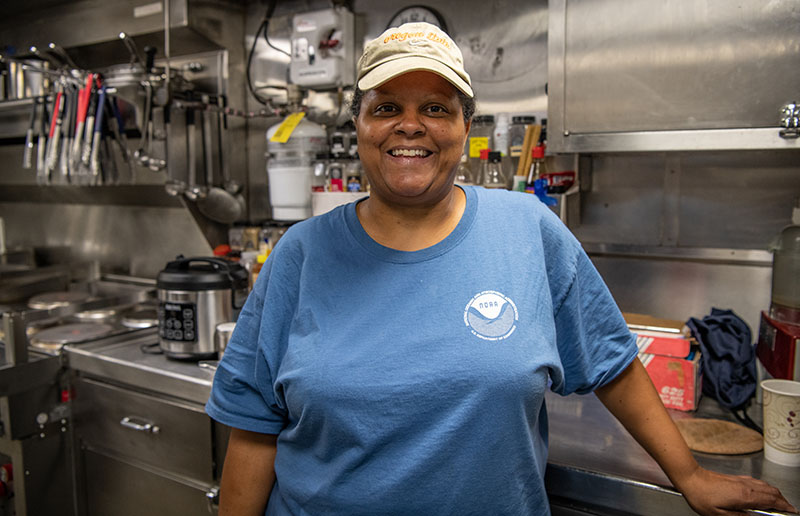
Image courtesy of the NOAA Office of Ocean Exploration and Research, Deep Connections 2019. Download larger version (jpg, 30 MB).
Second Cook
What is your role on the ship?
My role is to keep the galley and the mess clean, and to help out with the cooking and baking on a given ship. When I’m on the ship, my days are busy and hectic, starting with preparing breakfast. I’m always learning new recipes and new things about the job, the ship, and the cooking areas. I’m glad that I can contribute great food and great conversation to the ship’s operations. The ship is similar to my large family, in a way.
How did you get here?
I grew up in Pascagoula, Mississippi. I had a great childhood, before cell phones and even cable in some places. I had fun because I had a big family—with three sisters and a brother, we were always playing games and playing outside. Growing up, I had thought about careers as important to making a living; and that perhaps that meant a need to go to college. Since then, I’ve discovered that sometimes trade school leads to just as good a living. The career path that led me here was not something I had planned—I was previously a teacher in Savannah, Georgia. I happened to cross paths with an old friend, an engineer with NOAA, who told me about this job, and that’s what brought me to NOAA.
Can you share a favorite moment at sea?
My favorite moment being at sea so far was in Alaska, when I saw orca whales and their calves. I remember thinking, “Wow—this is amazing and I am seeing this with my own eyes!”
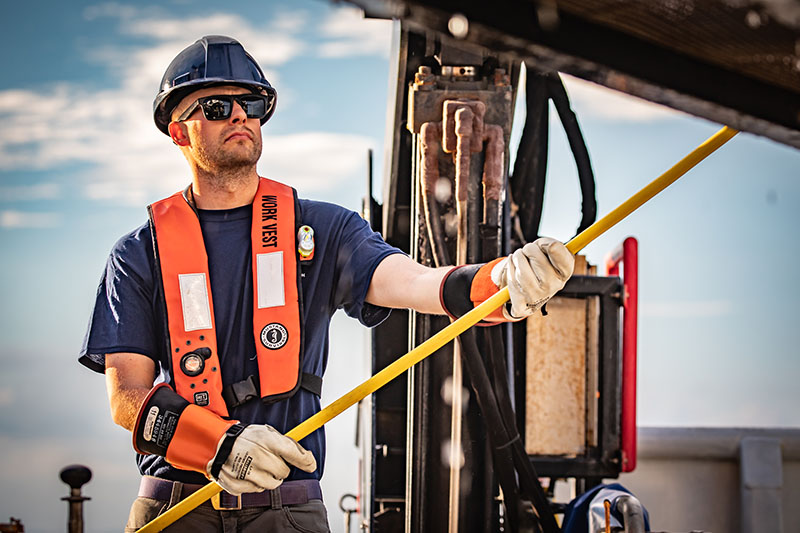
ROV Mechanical Engineer Dan Rogers. Image courtesy of Art Howard, Global Foundation for Ocean Exploration, Deep Connections 2019. Download larger version (jpg, 11.7 MB).
ROV Mechanical Engineer
Global Foundation for Ocean Exploration
What is your role on the ship?
Our team typically wakes up at 6 am to conduct pre-dive checks on the ROVs before breakfast. We launch the ROVs after breakfast and then throughout the day we’ll swap between shifts as ROV pilot, co-pilot, and navigator in the control room, as well as working winch and deck shifts. Once the dive is over, we recover the ROVs and do post-dive checks before dinner, and then fix any issues and prep for the next day’s dive after dinner. Sometimes we’ll end the day with a movie when everything is done.
How did you get here?
I was born and raised in Alaska, but moved to Hawaii while I was in high school. I was very interested in the sciences growing up. Like most kids I dreamed of being an astronaut, and I discovered that I really enjoyed studying physical sciences in high school, so I studied astronomy and physics as an undergrad. Before I discovered that piloting ROVs on the bottom of the ocean was a job that exists, I went through several education and career phases: I worked in informal science education at the Bishop Museum in Hawaii, and in video production and storytelling for several years. I started grad school studying renewable energy, before transitioning into a marine robotics lab to finish up my master’s degree. My advisor in grad school had worked with the Okeanos program for many years and brought me out as a student. I continued working on the ship after I graduated.
I really appreciate the mission of the Okeanos Explorer. Sailing to new places in the ocean and discovering new creatures and geological features side-by-side with scientists is very rewarding. It is so cool to actually go to places that most people only look at on a map, and for the purpose of science and exploration. It’s also great to hear about when the work we are doing directly contributes to important ocean policy-related decisions by the government. I’m glad that I can help by operating the technology required to do this.
If you could give advice to your younger self, about your career or your approach to it, what would you say?
Try many things—apply for jobs and internships to actually get work experience in a field that you are interested in. I transitioned my education and career path many times before I discovered something that I was really passionate about. But you never know for sure if you will like a job before you try it yourself. Explore.

Image courtesy of Art Howard, Global Foundation for Ocean Exploration, Deep Connections 2019. Download larger version (jpg, 37.7 MB).
Day job: Marine Geologist at the U.S. Naval Research Lab
Expedition Role: Geology Science Lead
What is your role on the ship?
On this expedition aboard the Okeanos, my job is to represent the scientific needs of the marine geology community, and contextualize the geological phenomena we observe during dives. The bulk of my work time-wise is commentating during our dives, but I am also responsible for processing samples, writing dive summaries and pre-dive plans, and conferring with scientists on shore.
On shore, my job is to provide the US Navy with the most accurate and comprehensive knowledge possible of the seafloor and subsurface. I spend most of my time making predictions (or estimates) of seafloor properties using numerical models. I also go out to sea to collect data that trains and validates our models.
How did you get here?
I grew up in landlocked Pennsylvania, but despite that I have always been interested in the marine environment. I attribute this to childhood vacations to the Outer Banks and some great picture books of eerie deep-sea life. Accordingly, I always wanted to be a marine biologist. I made a couple pragmatic career decisions that turned out well. I had to choose between majoring in German or marine science in college, and decided on marine science as STEM degrees are more marketable than liberal arts (I took German as a minor instead). In my sophomore year of undergrad, I had to choose between marine biology and marine geology as a focus area, and again chose the field that I liked equally well but was less saturated (geology).
In my line of work, I find the idea of not knowing exactly what my next day’s work is going to yield very appealing. Research is a very nonlinear process and it leads one down interesting rabbit holes. And we have the latitude to pursue our own ideas: as long as it yields beneficial, original knowledge, few ideas are discouraged.
What do you like most about being at sea?
I like that being out at sea removes you from the minutiae of the job (meetings, deadlines, etc.), but you’re still in the work mindset. It allows you to step back and assess your current research philosophy from a 1,000 foot view.
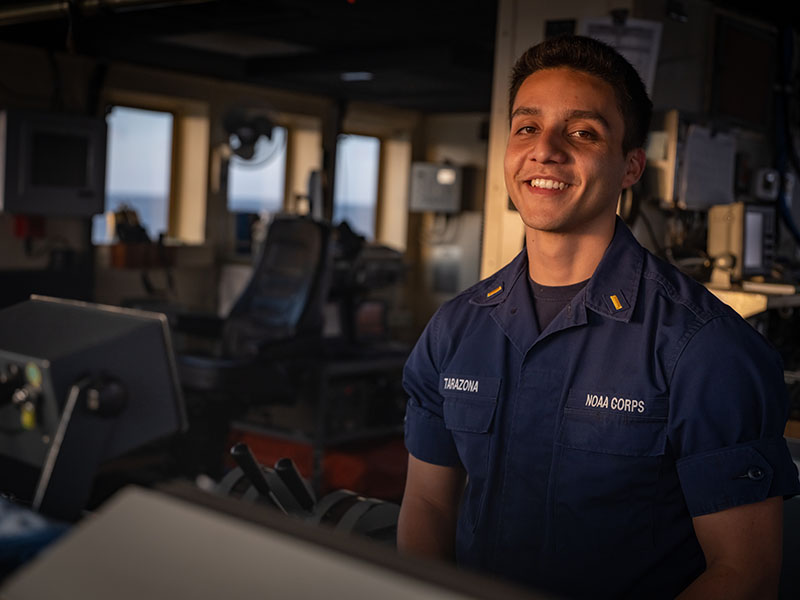
Image courtesy of the NOAA Office of Ocean Exploration and Research, Deep Connections 2019. Download larger version (jpg, 52.3 MB).
Junior Officer
NOAA Corps
I grew up between Miami, Florida, and Colombia, switching back and forth between the two. In Miami, everything is flat. But I remember when I first moved to Colombia—I lived on the top of a mountain, and it was my first time really seeing topography. It was a whole different world that I’d never been exposed to before. I was the first in my family to go to college, and when I got there, I initially wanted to be an industrial engineer—but I sat in on a class and I knew it wasn’t for me. I switched to geology within the first week.
I earned my B.A. in Geology, but I wasn’t sure what to do once I graduated and moved back home. My first job was working as a park ranger at Bill Baggs Cape Florida State Park. I loved it because I got to be outdoors every day. While I was there, a colleague sent me a newsletter that mentioned that a NOAA Corps Officer was doing a patrol within the park—it was a chance mention, but I was intrigued so I looked it up. Everyone knows about NOAA; it's a huge agency. But I hadn’t heard about NOAA Corps. It was in the back of my mind for a while.
I ended up getting another job at a radiocarbon dating lab, which was very solitary—you spend a lot of time in front of a fume hood. I wanted to be outside again! That’s when I decided to look into NOAA Corps. Six months later I was leaving for Basic Officer Training Class. You learn a lot about yourself there, and you learn how to deal with stress, which has been extremely helpful out here at sea. They get your feet wet in training, but the majority of the learning has been on the job. I’ve only been here on the Okeanos for three months and have learned a huge amount. Sometimes I'll be working out and there’ll be pilot whales on the port beam, and it’s just surreal. Not many people can say they do what we do—explore the ocean, see new species for the first time. I don't think you could ever get bored.
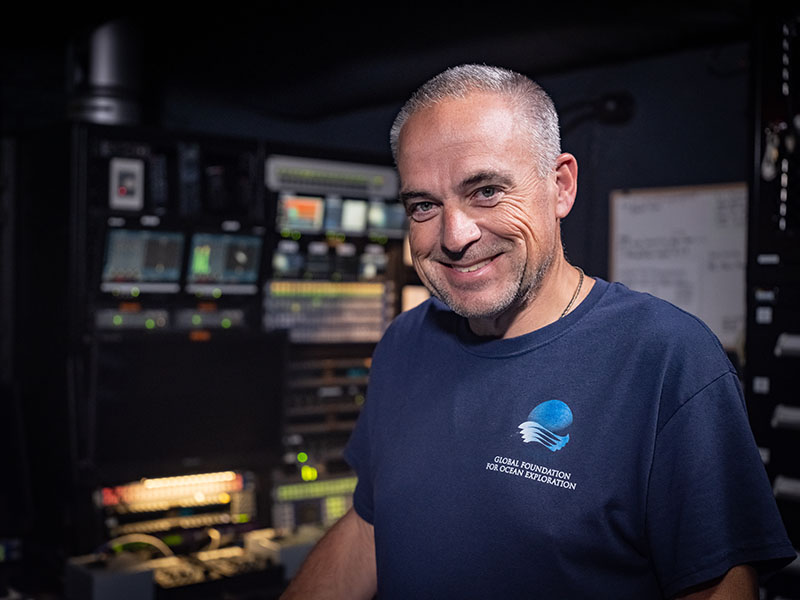
Image courtesy of the NOAA Office of Ocean Exploration and Research, Deep Connections 2019. Download larger version (jpg, 72 MB).
Network Security Engineer
Global Foundation for Ocean Exploration
What is your role on the ship?
My main role is to provide a stable, efficient, and state of the art network platform that can support the daily operations of the ROV, video, voice, and mapping systems. This platform quickly and reliably provides NOAA and all the research teams the information they need to be able to study the oceans in real time.
On the ship, my typical day includes monitoring and maintaining the network system that provides this connectivity from the ship to shore. This includes monitoring the bandwidth usage of the systems to manage the traffic, so that we don’t drop any critical data. I also work with the ROV team and do watches as a navigator and on deck. My field of work is typically done on shore in clean data centers, so to take this technology and put onto a ship is a big challenge, with all the different systems it must support.
How did you get here?
Being at my age that would be a very long story but I grew up mostly in Texas. I was, I think, a very typical kid. I knew early in high school that I wanted to do something in electronics or computers. That was mainly because my dad was in a technical field and I had many opportunities to learn from him. I had planned to follow in my dad’s footsteps—he is an electrical engineer. However, my path took me towards computers and networking; I’ve been in the field for about 30 years now, starting just out of high school. Twenty-six years of that was at MCI/Verizon. I focused on my family early in my career, so being home and steady hours were my priorities. My wife and I got married after graduating high school, 31 years ago to the day, on the day that I get home from this expedition. We have three kids and five grandkids now, so since the kids have grown up, I’ve been able to change my career plans around.
When I was growing up, my dad worked with research vessels and designed the satellite systems for several different ships. I found this work fascinating because it tied together my love of technical work and with being outside and on the water. So, when I was approached with an early release package from Verizon, I had already been in contact with GFOE, who were looking for a network engineer. And, the plan came together—my wife and I discussed it, and within six months I was out here on the ship designing network solutions and sailing. I should just mention that my dad has been working with GFOE for many years and we will actually be on the ship together later this year. After watching my dad work on several different ships, it is really neat to be able to work with him here.
If you could give advice to your younger self, about your career or your approach to it, what would you say?
My main advice would have been to make sure that you follow your dreams along with your plan. Plans are very structured and following them too tightly can stifle your dreams. So, balance your plans with your dreams.

Image courtesy of Art Howard, Global Foundation for Ocean Exploration, Deep Connections 2019. Download larger version (jpg, 24 MB).
Day job: Deep-sea Research Associate at the University of Hawaii
Expedition Role: Biology Science Lead
What is your role on the ship?
As the Biology Science Lead, I provide critical scientific guidance to guide the biological exploration of the mission, and facilitate the communications between ship and shore-based participants via telepresence technology. I am also responsible for engaging the broader scientific community in pre-cruise meetings and planning sessions, and completing post-cruise reporting.
How did you get here?
Growing up in the suburbs of Chicago, Illinois, I was always curious about the natural world, but I wasn’t until my family vacationed in Maine one summer that I discovered my passion for marine science. We stayed in Acadia National Park, where I joined the junior ranger program. The program encouraged us to visit different areas of the park and learn about the native plants and wildlife. The place that fascinated me the most were the tide pools along the rocky coast. Staring down into their shallow depths was like looking through a portal to another world, a world that beaconed for exploration. I saw small fish and invertebrates that were both weird and wonderful. From that moment onward, I was hooked. Later in our trip I met a young marine scientist during a whale watching tour, who told us about her career studying marine mammals. When I learned that studying the life in the ocean could be a job, I never had any doubt what my future career would be.
After completing my bachelor’s degree in marine science at Eckerd College in Florida, I worked for three years at Water and Air Research, Inc., as a marine and freshwater taxonomist and benthic ecologist. My work there included doing assessments of impacts from the Deep Horizon oil spill on coastal ecosystems, impacts to benthic communities from dredging, and other human impacts on freshwater streams and rivers. During this time, I learned a lot about benthic ecology and invertebrate identification, which has helped me greatly in my career.
I decided to return to school in 2013 to pursue my master’s in marine science at Hawaii Pacific University. My thesis research, which focused on the community structure and development of deep-sea corals, put me in contact with the Okeanos Explorer. In 2015, I planned and helped orchestrate a dive, via telepresence, off the southern point of Hawaii during the 2015 Hohonu Moana Expedition, and utilized the data collected there to compare varying aged coral communities on the Hawaiian lava flows. As deep-sea coral species grow at extremely slow rates, research on these lava flows provides a known maximum age for each community, since new communities begin to form on top of the lava substrate as soon as it cools. This allows for the examination of community development across longer time scales than would be normally possible within a human lifetime, if you were just to observe it.
Later, I sailed with the Okeanos Explorer as part of the Explorer-in-Training program, learning how to collect and process sonar data. I was then hired at the University of Hawaii as part of a team of scientists that specializes in imagery analysis. We most notably assembled the benthic animal guide and completed the video analysis from the 2015-2017 CAPSTONE expeditions. I’ve also worked for the past few years designing and maintaining the Hawaii Undersea Research Laboratory (HURL) archive , and am a part of the team that operates the ROV Lu‘ukai. My expertise in deep-water coral ecosystems led me to an invitation to be a science lead for the Deep-sea Symphony: Exploring the Musicians Seamount expedition in 2017, and again for this expedition, Deep Connections 2019: Exploring Atlantic Canyons and Seamount of the U.S. and Canada.
My hope is to inspire future generations of scientists and make new connections with scientists around the world by sharing my knowledge and passion for the deep-sea. There is so much still to be learned about the deep-sea. Every dive is a new experience. No one has been to or seen any of the places we visit with the ROV, and you never quite know what to expect. One day you might see a new species no one has ever seen before, the next there might be an awe inspiring community of deep-sea corals and sponges. Every day, I think of new questions that don’t yet have answers. Through exploring and characterizing the animals in the deep-sea, I hope to start answering some of these questions—but mostly I hope to inspire new questions that will keep myself and others motivated and engaged in this work for years to come.
If you could give advice to your younger self about your career, what would you say?
I would advise myself to take computer science classes and learn a few coding languages. So much of science is accomplished with computers, and being confident in write scripts will save a lot of time and frustration in the future. Coding can also be fun and rewarding!
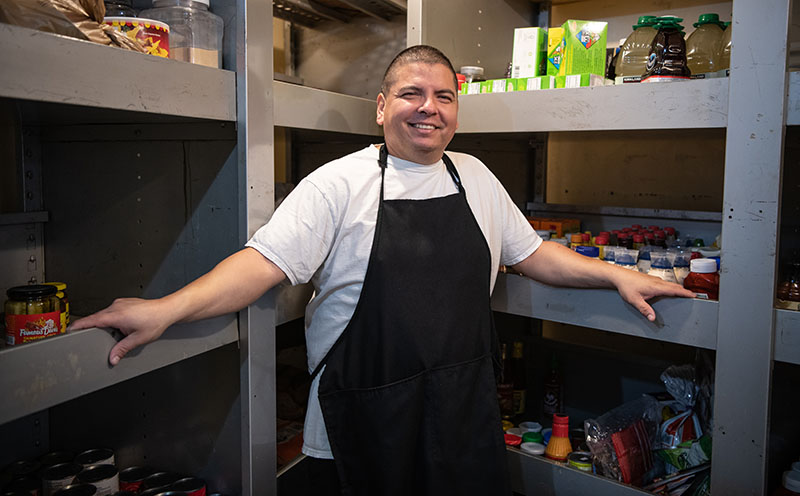
Image courtesy of the NOAA Office of Ocean Exploration and Research, Deep Connections 2019. Download larger version (jpg, 23.7 MB).
Chief Steward
What is your role on the ship?
I coordinate the safe and timely preparation of food service, plan the procurement of food, as well as maintain ships linen. I start work each day at 5:30 am, put out three hot meals plus an occasional birthday or special occasion cake, am off by 7 pm, and then do it all again—I like being a small part of it all, traveling, and the camaraderie onboard. Through my work I hope to give a little boost to everyone’s day, and help them enjoy each other’s company over a good hot meal.
How did you get here?
I didn’t think about a career path much as I didn’t have that kind of direction or mentorship in my life. But all of my early teenage jobs were labor intensive and near the water on the 32nd St Naval Station in San Diego. From those early experiences, I learned that attention to detail and planning were necessary steps to be successful at anything in life. When I first started in this line of work, it was for the adventure—but after getting married, it also became about being able to provide for my family and to set an example of hard work and sacrifice, that will help give my kids the direction and guidance they need to find their own paths in life. I’d advise a younger version of myself to look at learning as an adventure, with new discoveries always just another branch higher. I had a lot of fears when I was younger, and I wish I could have climbed a little higher sooner in life—looking back there were some pretty amazing views. But I could have reached them a lot earlier if I had been prepared to overcome my fears.
Can you share a favorite moment at sea?
There are too many moments to share, but I do like being out on deck at night and seeing the stars. It reminds me of when I was younger and used to go on camp-outs with the Boy Scouts. It’s truly beautiful to behold.
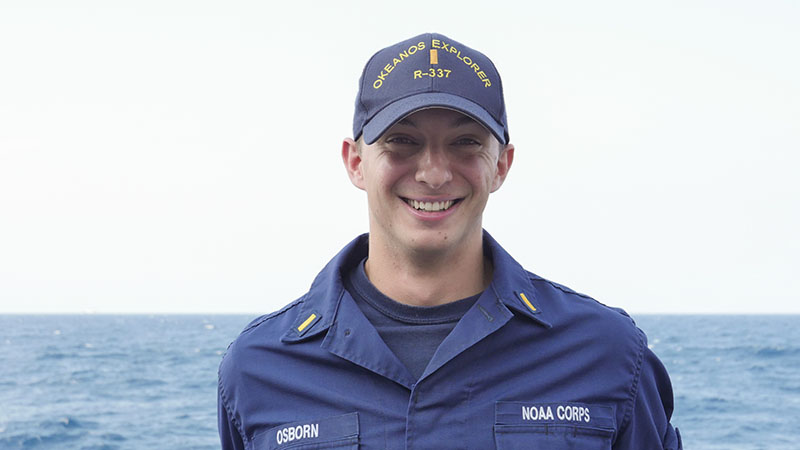
Image courtesy of the NOAA Office of Ocean Exploration and Research, Deep Connections 2019. Download larger version (jpg, 23.7 MB).
Junior Officer
NOAA Corps
What’s an average day like for you in your job?
Wow, it’s a bit difficult to have an average day, every day is always so different. On the ship, I stand a total of 8 hours a day on watch as a deck officer. These 8 hours are broken into two 4 hour blocks, so that I have 4 hours on watch, 8 hours off, twice a day. I drive the ship, maintain a safe navigation watch, operate the ship’s dynamic positioning during ROV dives, and am the ship’s safety officer. When I’m not on watch, I’m usually performing safety inspections, working on morale events, doing ship inventory, working on my underway officer of the deck (OOD) workbook, or helping with anything that needs to be done around the ship. A typical workday for a NOAA Corps Officer is usually 12 hours. I try to leave an hour or so to visit the ship’s gym but this luxury can only be enjoyed when I’m not bogged down with work.
I’ve been living consistently on the ship ever since I first reported for duty in December of 2018. The Okeanos is a unique ship that can work anywhere on the planet, so we’re away from “home” pretty often. When we’re in port, I have much more time to work on other office work or inspections since I’m not spending 8 hours a day driving the ship. The Okeanos typically docks in new places, so I explore whatever city I find myself in. I enjoy trying the local flavors, visiting some parks, and of course checking out any aquariums.
How did you get here?
I was born and raised in California, but I actually lived in Guatemala between the ages of 9 and 18. My family initially moved there to assist an uncle who ran an orphanage in the highlands. Though it wasn’t the original intent, our family ended up staying in the country for 9 years. While living in Guatemala, my family frequently traveled to El Salvador, Mexico, and back to the States, so an affinity for traveling was instilled in me at a young age. I was a strange kid growing up; I’d prefer watching nature documentaries to literally anything else. I loved animals and I loved the ocean, so it only made sense that I pursued something that would involve both. When I graduated from high school in Guatemala, I moved back to California to attend the University of California at San Diego to study marine biology. I had no idea what I wanted in terms of a career but I knew it had to involve the ocean. I was fortunate enough to spend some time volunteering at NOAA’s Southwest Fisheries Science Center nearby, and even luckier to sail on a few research cruises on the NOAA Ship Reuben Lasker. It was on these trips that I found out about the NOAA Corps and started pursuing this career. After college I spent time traveling and applying to the Corps. I spent a month in Honduras doing research on dolphins, a month in Indonesia doing research on sharks and reefs, and two months in the Dominican Republic working out of a dive shop and towards getting my Dive Master certificates. I really enjoy traveling, so it's a good thing that I started working with NOAA Corps—I’m always moving around and I love it.
There aren’t many jobs like this. I’ve already learned an incredible amount and there’s so much more to learn. I feel like I am constantly being challenged and growing everyday with this job. I’m being paid to travel, do science, and literally explore the ocean; the adventurer in me is freaking out. I really appreciate how unique this job is. The younger version of me never would have believed that I’d be driving a deep-sea exploration ship with robots for NOAA. It’s like watching a BBC deep-sea documentary live.
Can you share what you like most about being at sea?
Every sunrise and sunset is different and they never get old. You won’t get better stargazing conditions anywhere else in the world. I get to live and work with amazing people who are just as passionate (or even more) about ocean science as I am. The sea life is also amazing; I’ve seen whales, dolphins, bioluminescence, turtles, tuna, low flying military jets, Coast Guard helicopter rescue training—it all beats sitting in an office.
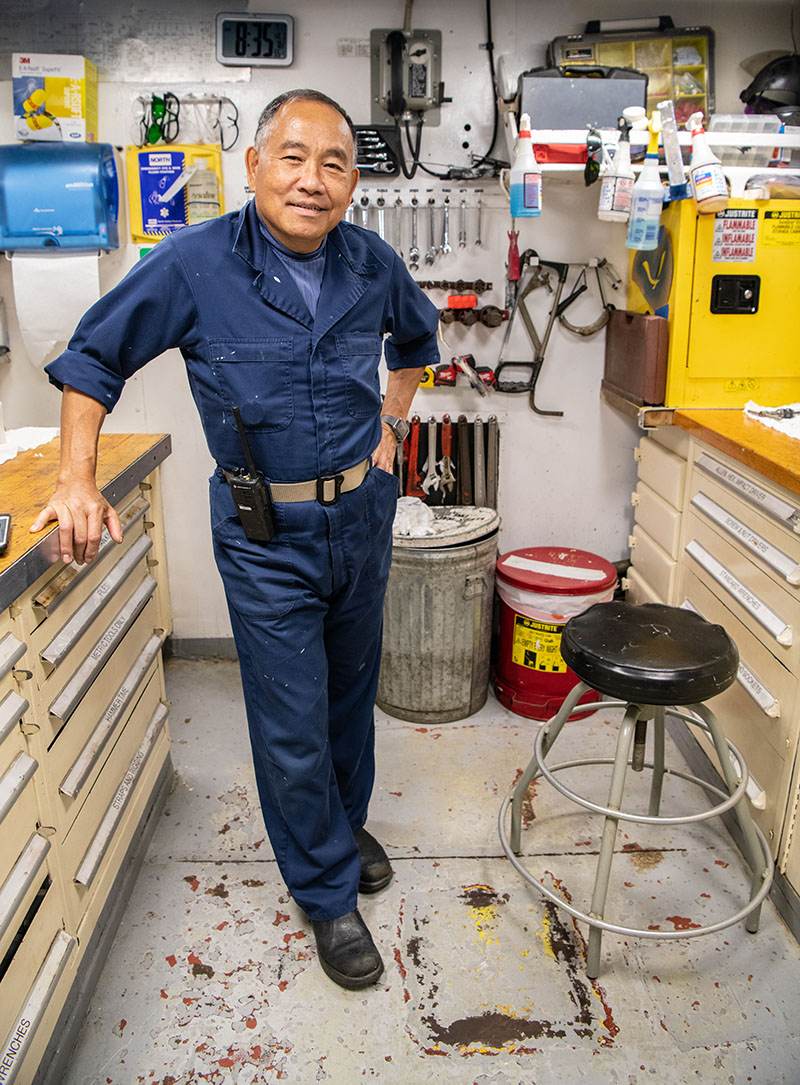
Image courtesy of the NOAA Office of Ocean Exploration and Research, Deep Connections 2019. Download larger version (jpg, 27.1 MB).
First Engineer
What is your role on the ship?
My main role is assisting in ship engineering operation, and management of the department's personnel, materials, and funding resources to meet the ship's mission objectives.
How did you get here?
I was born and educated in the Philippines. Growing up, I was always curious, always tinkering, and had an insatiable desire to know how things are made and how they functioned. But working on a ship with NOAA was never a part of my plan after I retired from the US Navy. I wasn’t even aware of its existence. In 2003, I retired from the US Navy for about 5 months. But retired life didn’t really match my outlook or desire to be productive, so I applied for the Military Sealift Command (MSC), which hires civil service mariners for seagoing positions, and to a position with NOAA as an engineering crewmember. I just happened to see job posting for NOAA while looking for opportunities with the MSC. I took a job as an Unlicensed Junior Engineer on the NOAA Ship Hi’ialakai in 2004. Two years later the Chief Engineer of that vessel transferred to the Okeanos Explorer and invited me to join. I’ve been on the Okeanos ever since, although I’ve also served as an augmenter on several other NOAA ships including the Thomas Jefferson, the Oregon, and the Shimada. What I like most about my job is that it’s very dynamic. There’s never a dull moment working and learning with the young, and sometimes the old, and in supporting the scientific missions that take place. At the same time, it gives me the ability to contribute to the training and professional development of others on the ship.